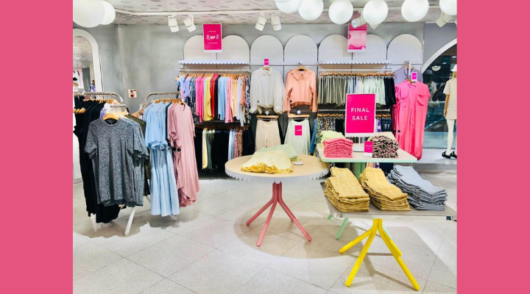As we move into the peak retail season, representing two-thirds of some retailers’ annual profits, the energy across departments in our industry is palpable. But amid the rush, many retailers continue to overlook one of their most high-potential brand channels…the physical store. From industry conversations I hear and event panels, environmental design of retail spaces feels too often like an afterthought. But the investment in bricks and mortar is considerable, with leases and fit-outs o
outs often stretching into hundreds of thousands.
It’s a missed opportunity, with data indicating the financial benefits for those that are able to optimise the in-store experience. Indeed, PwC research also found that those customers who have a positive in-store experience are more likely to increase basket size, return more often, and recommend brands to others.
So what are some of the ways to tap into the potential of this brand channel over the coming months?
New sensations
In contrast to our digital worlds, the physical store is a living, breathing space where all of our senses can be engaged. This provides more opportunities for retailers. Research consistently demonstrates that sensory experiences directly influence customer behaviour, whether it’s ambient scents that can increase dwell time and spending, or curated lighting and music can enhance mood and reinforce brand identity.
Well-designed environments don’t just make customers comfortable. They also prime them emotionally leading to changes in behaviour. This is why the continuous evolution, as well as maintenance of stores should not be considered a cost, but a crucial marketing investment.
The people behind the experience
What was your most remarkable shopping experience? The one that left you desperate to tell others about it. I suspect it involved the people within a store, rather than simply a price, and how they made you feel.
The atmosphere created by your team sets the tone for how others experience your store.
McKinsey has shown that outstanding in-store service is one of the top three drivers of customer advocacy. But great service is inseparable from the environment. Team members who spend long days in optimally designed, well-lit, calming surroundings are not only more motivated but better able to deliver the kind of service that leaves a lasting impression. Staff training along with the right environmental surrounds can serve to amplify the customer experience.
Wayfinding
Empirical studies have proven the correlation between a relaxing layout of a store, and positive emotional response from customers. This can impact their behaviour, lifetime value and their willingness to recommend your brand.
All by how they feel in your store:
Was it easy to find what they were looking for?
Did time pass quickly because they were engaged?
Or did they end up frustrated and leave without getting what they came for?
Retailers can implement the findings of this research by ensuring there are visible and clearly comprehensible signs, navigating people to products, but also to facilities throughout the store and in particular at entrances/exits.
Maximise foot traffic
Signage and signals towards getting customers over the threshold start before your display window. If you’re based in a shopping centre, it starts at the car park. If you’re on a main street it starts 100m from the doors, as soon as someone is physically able to see you, it begins.
According to Nielsen, 59 per cent of shoppers prefer buying from brands they recognise. That means your logo, colour palette, and storefront design must act as early signals to draw customers in long before they shop your shelves.
Displays
Visual merchandising in-store directly impacts a customer’s perception of value and in turn sales. It’s something that higher-end stores should pay close attention to.
Studies show that ‘display location’ and ‘product adjacency’ can help with purchase intent, by reframing how customers evaluate worth. For example, products with high profits can be placed next to high-priced items to elevate perceived quality and increase the likelihood of purchase.
Well-designed displays are not only aesthetically pleasing, but they’re good for the bottom line as well.
Continuous evolution
Retailers need to keep evolving. Despite what your gut may feel about changes, I guarantee your customers are more flexible than you think. Research shows that while digital channels can win users, it does not win their trust. Almost 90 per cent of shoppers agree that business values matter, and they expect retailers to innovate to meet their values and preferences. New store designs that introduce novelty while maintaining comfort and clarity will alter behaviour with customer satisfaction measurable at the tills.
The in-store channel already carries heavy costs. But when designed thoughtfully, it transforms from a sunken cost into a growth driver, deepening brand connection and driving profitability in ways no other channel can replicate.
Rachael Hockaday is the managing director of Haeday
Further reading: Uniqlo’s Joey Tong on the thinking behind the brand’s Orchard flagship refresh







